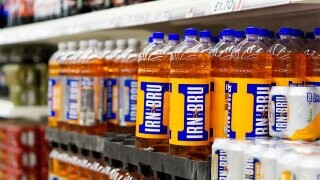5 Soft-Drink Giants That Are the Coca-Cola of Their Countries

Sorry, Pepsi lovers — Coca-Cola still accounts for 69 percent of U.S. cola sales (swell), dwarfing Pepsi’s mere 27 percent. Even Dr Pepper has caught up to you. Honestly, you should be embarrassed.
Don't Miss
But you’re not alone in shunning America’s favorite spicy water, at least on a global scale. Despite its best efforts, there are places on Earth where Coke has failed to reign supreme. And you know what its best efforts look like (polar bears and murder).
Saudi Arabia
Vimto, a Kool-Aid-like fruit-flavored sugar water, is actually produced in England, but it sells 35 million bottles in the Middle East, mostly in Saudi Arabia, every year. That’s mostly because Muslims figured out that downing a big bottle of it at sundown is a great way to get through fasting during Ramadan, to the point that stores have to limit customers to two bottles each during the observation like they’re Taylor Swift-branded Stanley cups.
North Korea
If Coca-Cola traded with North Korea, they’d never hear the end of it, so while you can sometimes find Chinese Coke in fancy shops in the big cities, they mostly have to make do with “cocoa-flavored sweet drinks.” There seems to have been a disastrous error of translation, as Coca-Cola only bears the slightest linguistic resemblance to cocoa, but the most popular brand, Ryongjin, which is branded exactly like Coke, apparently does, in fact, taste like Coke and not cocoa. Like the rest of North Korea, it’s misleading and unsettling.
Inca Kola
Having the good fortune of launching one year earlier, as well as an uncomfortably patriotic branding effort, Inca Kola shot to the top of the Peru soft drink charts by the ‘70s, and Coke never had a chance to compete. In fact, they had to add more sugar to even have a chance of appealing to devotees of Inca, which has been described as bubblegum-like and so sweet that Coke is “almost subtle” by comparison. By 1999, Coke gave up and just bought half of Inca.
India
In 1977, India began requiring foreign corporations like Coke to share their formulas and their profits with Indian companies, so Coke was like, “Cool, smell ya later.” In the void left in their absence, Indian food giant Parle Agro released Thums Up, which they claimed was even fizzier and spicier than Coke. They must have been right, because they soon had 85 percent of the market share, and when Coke returned in 1993, they bought them.
Scotland
Irn-Bru, an orange-colored beverage that has been compared to “a fizzy cream soda” and, less kindly, “bubble gum with a hint of steel,” has outsold Coca-Cola in Scotland for more than a century. In fact, 20 cans are sold in the country every second. Its winning secret seems to be just ridiculous amounts of sugar and caffeine, but most importantly, that purportedly makes it a great hangover cure. And come on. It’s Scotland. That’s obviously what really matters.